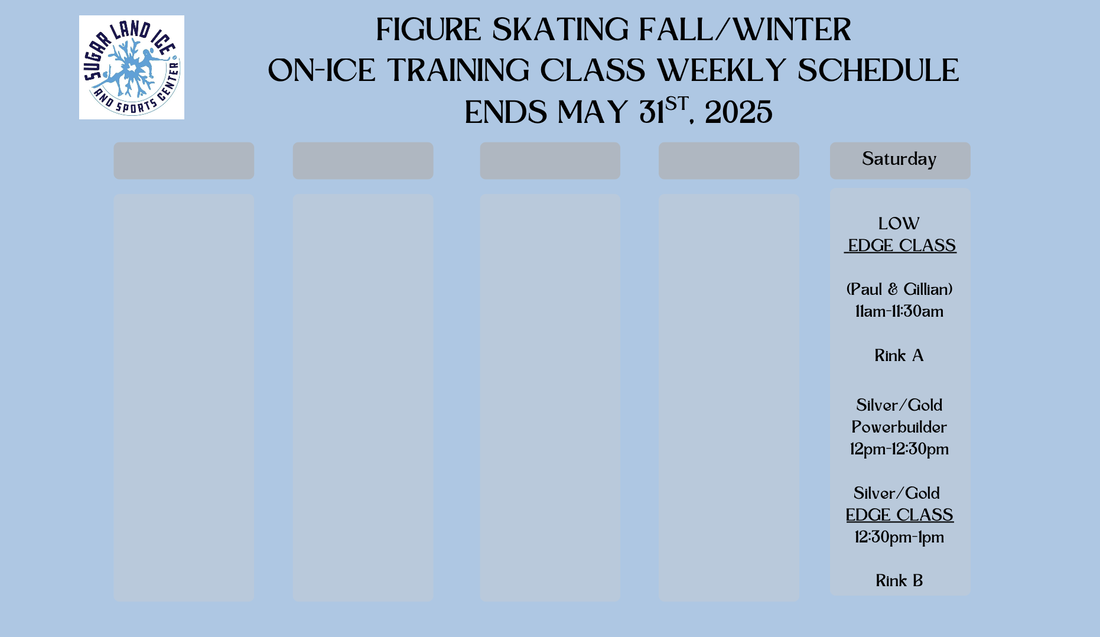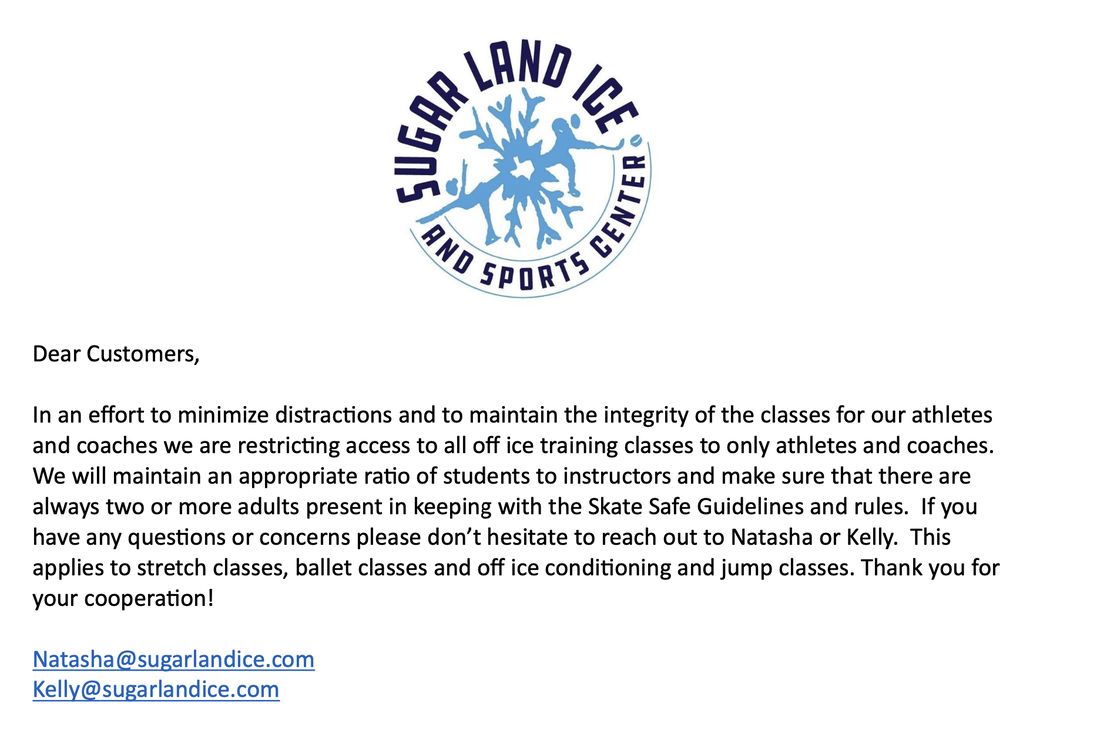
USFS Freestyle Session are for Figure Skaters Only Levels : Practice & lessons Freeskate 1 to through Senior Gold Level Must follow rules of USFS Freestyle Ice pattern etiquette *No Private Lessons with lower levels Snowplow-PreFreeskate without special permission*
LOW/HIGH Combined Freestyle: are for Private lessons Snowplow-Prefreeskate), Freeskate 1 through Senior Gold level practice & lessons and All Approved Hockey coaches for Private Power Hockey lesson (No sticks or Pucks), Must follow rules of USFS Freestyle Ice pattern etiquette
“OPEN" Freestyle Sessions for all Approved hockey coaches for hockey private lessons (No sticks or Pucks) and figure skating lower levels under Freeskate 1 for practice & lessons Must follow rules of USFS Freestyle Ice pattern etiquette
Public SessionIs for Private Hockey lesson, Recreational & practice ice for Snowplow-Prefreeskate levels and Private lessons for snowplow through pre Freeskate
LOW/HIGH Combined Freestyle: are for Private lessons Snowplow-Prefreeskate), Freeskate 1 through Senior Gold level practice & lessons and All Approved Hockey coaches for Private Power Hockey lesson (No sticks or Pucks), Must follow rules of USFS Freestyle Ice pattern etiquette
“OPEN" Freestyle Sessions for all Approved hockey coaches for hockey private lessons (No sticks or Pucks) and figure skating lower levels under Freeskate 1 for practice & lessons Must follow rules of USFS Freestyle Ice pattern etiquette
Public SessionIs for Private Hockey lesson, Recreational & practice ice for Snowplow-Prefreeskate levels and Private lessons for snowplow through pre Freeskate
USFS Freestyle Session are for Figure Skaters Only Levels : Practice & lessons Freeskate 1 to through Senior Gold Level Must follow rules of USFS Freestyle Ice pattern etiquette *No Private Lessons with lower levels Snowplow-PreFreeskate without special permission*
LOW/HIGH Combined Freestyle: are for Private lessons Snowplow-Prefreeskate), Freeskate 1 through Senior Gold level practice & lessons and All Approved Hockey coaches for Private Power Hockey lesson (No sticks or Pucks), Must follow rules of USFS Freestyle Ice pattern etiquette
“OPEN" Freestyle Sessions for all Approved hockey coaches for hockey private lessons (No sticks or Pucks) and figure skating lower levels under Freeskate 1 for practice & lessons Must follow rules of USFS Freestyle Ice pattern etiquette
Public SessionIs for Private Hockey lesson, Recreational & practice ice for Snowplow-Prefreeskate levels and Private lessons for snowplow through pre Freeskate
LOW/HIGH Combined Freestyle: are for Private lessons Snowplow-Prefreeskate), Freeskate 1 through Senior Gold level practice & lessons and All Approved Hockey coaches for Private Power Hockey lesson (No sticks or Pucks), Must follow rules of USFS Freestyle Ice pattern etiquette
“OPEN" Freestyle Sessions for all Approved hockey coaches for hockey private lessons (No sticks or Pucks) and figure skating lower levels under Freeskate 1 for practice & lessons Must follow rules of USFS Freestyle Ice pattern etiquette
Public SessionIs for Private Hockey lesson, Recreational & practice ice for Snowplow-Prefreeskate levels and Private lessons for snowplow through pre Freeskate
ON-Ice Class Levels:Restricted to Figure Skaters
- GOLD & IJS Levels: Excel Preliminary & Pre-Preliminary Well Balanced and above
- Silver Levels: Pre-Freeskate thru Excel Pre-Preliminary
Explaination of LEVELS FOR ALL "OFF ICE" CLASSES :
Off Ice Training is as important for a figure skater’s development to compliment on-ice workouts. Off-Ice exercises should be incorporated early in the skater’s training regimen to increase a skater’s fitness, strength and speed, improve body posture and endurance, and reduce or prevent injury.
Off-ice training plays a major role in developing those physical athletic qualities which leads to improved self-confidence and mental fortitude.
The frequency of off-ice training will depend on the skater’s level, goals, and schedule. Typically, in the off-season, it’s best to do off-ice training anywhere between 3-4x per week. During the season, 2-3x per week is a good amount of days for off-ice training.
To succeed in the sport of figure skating, here are some of the physical attributes that should be improved during off-ice training:
1. Pillar Strength
To maintain balance, control, and good positioning when rotating and jumping, the skater must have a strong core to be consistent at performing these movements well. The core involves everything from the torso and hips.
2. Strength and power
In order to hold a position, explode up for a jump, or carry and toss a partner, a skater must possess a certain level of strength. A stronger skater will be more resilient throughout the season which will help them stay healthy on the ice.
3. Explosive Power
Skating fast, jumping high, and landing well starts with your ability to generate force quickly. An explosive skater will be able to complete their program efficiently with speed.
4. Balance
Since most (if not all) movements in figure skating are done on one leg, it is important to train the skater to have better sense of where their body is in space. It goes back to point number one. Without proper core strength, it will negatively affect the skater’s ability to balance.
5. Flexibility & Stability
The ability to take your joints through full range of motion and being able to control that range of motion can help a skater perform movements on the ice efficiently and reduce injury potential.
- HIGH Levels: Excel Preliminary & Pre-Preliminary Well Balanced and above
- LOW Levels: Pre-Freeskate thru Excel Pre-Preliminary
- "OFF-Ice" Conditioning Class Levels: Freeskate 1 and above
Off Ice Training is as important for a figure skater’s development to compliment on-ice workouts. Off-Ice exercises should be incorporated early in the skater’s training regimen to increase a skater’s fitness, strength and speed, improve body posture and endurance, and reduce or prevent injury.
Off-ice training plays a major role in developing those physical athletic qualities which leads to improved self-confidence and mental fortitude.
The frequency of off-ice training will depend on the skater’s level, goals, and schedule. Typically, in the off-season, it’s best to do off-ice training anywhere between 3-4x per week. During the season, 2-3x per week is a good amount of days for off-ice training.
To succeed in the sport of figure skating, here are some of the physical attributes that should be improved during off-ice training:
1. Pillar Strength
To maintain balance, control, and good positioning when rotating and jumping, the skater must have a strong core to be consistent at performing these movements well. The core involves everything from the torso and hips.
2. Strength and power
In order to hold a position, explode up for a jump, or carry and toss a partner, a skater must possess a certain level of strength. A stronger skater will be more resilient throughout the season which will help them stay healthy on the ice.
3. Explosive Power
Skating fast, jumping high, and landing well starts with your ability to generate force quickly. An explosive skater will be able to complete their program efficiently with speed.
4. Balance
Since most (if not all) movements in figure skating are done on one leg, it is important to train the skater to have better sense of where their body is in space. It goes back to point number one. Without proper core strength, it will negatively affect the skater’s ability to balance.
5. Flexibility & Stability
The ability to take your joints through full range of motion and being able to control that range of motion can help a skater perform movements on the ice efficiently and reduce injury potential.
For any questions regarding figure skating, please contact Figure Skating Director Natasha Kuchiki at Natasha@sugarlandice.com







